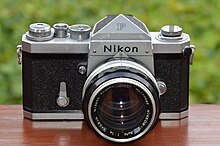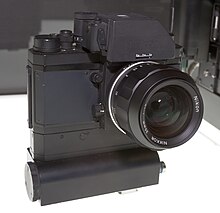The Redesigned Nikon F Camera Was Influenced By Which European Art Movement?
 | |
| Overview | |
|---|---|
| Type | 35 mm SLR camera |
| Lens | |
| Lens mount | Nikon F-mount |
| Focusing | |
| Focus | manual |
| Exposure/metering | |
| Exposure | manual |
| Wink | |
| Flash | non-ISO hot shoe, or PC socket for off-camera flash |
The Nikon F camera, introduced in April 1959,[one] was Nikon'due south first SLR photographic camera.[2] It was i of the most avant-garde cameras of its day. Although many of the concepts had already been introduced elsewhere, information technology was revolutionary in that it was the first to combine them all in one camera.[3] It was produced until October 1973 and was replaced by the Nikon F2. Aspects of its design remain in all of Nikon's subsequent SLR cameras, through the current Nikon F6 flick and Nikon D6 digital models (which still share its Nikon F-mountain for lenses). The "F" in Nikon F was selected from the term "re-f-lex", since the pronunciation of the start letter of the alphabet "R" is not bachelor in many Asian languages.[iv] That tradition was carried all the fashion through their peak line of Nikon cameras until the introduction of the Nikon D1 (digital) cameras decades after.
Specially modified Nikon F cameras were used in space in the early on 1970s aboard the Skylab infinite station.[five]
History [edit]

Nikon F professional SLR photographic camera with eyelevel prism and early NIKKOR-South Automobile 1:1,4 f=5,8cm (1959)
The Nikon F was the showtime 35 mm SLR system to exist widely adopted by professional photographers, especially photojournalists roofing the Vietnam War, as well as for use by NASA astronauts.[6]
It was originally priced at Us$186 with 50mm f/2 lens; in November 1963 the US price was $233 for the body with a standard prism plus $90 for a 50mm f/2 lens or $155 for a 50mm f/1.4.
A combination of design elements made the Nikon F successful. It had interchangeable prisms and focusing screens; the photographic camera had a depth-of-field preview button; the mirror had lock-up capability; it had a large bayonet mountain and a large lens release button; a unmarried-stroke ratcheted film accelerate lever; a titanium-foil focal plane shutter; various types of flash synchronization; a rapid rewind lever; a fully removable back. Information technology was well-made, durable, and adhered closely to the successful blueprint scheme of the Nikon rangefinder cameras. The camera was the offset to use the F-mount bayonet lens mount system, which is still used every bit of 2022. Lead designer of the Nikon F was Yusaku Kamekura, the man backside the 1964 Summertime Olympics logo.[seven]

Nikon's Photomic FTn camera and finder


Foreground: Nikon F with eyelevel prism; Nikon F with FTn Photomic prism; Nikon F with FTn Photomic prism and F36 motor bulldoze
The Nikon F evolved from a rangefinder camera, the Nikon SP. The prototype model, in detail, was an SP with a mirror box, pentaprism and larger lens mount grafted on.[8]
The F was a modular system camera, with various assemblies such equally viewfinders, focusing screens, and motor drives for 36-exposure and 250-exposure motion-picture show cassettes. Third parties manufactured other pic backs, such equally 2 Speed Magny moving picture backs—one using Polaroid 100 (later 600) blazon pack films, and another designed for 4x5 motion-picture show accessories including Polaroid's ain 4x5 instant film dorsum. Each of these assemblies could be fitted and removed, assuasive the camera to adjust to almost whatever task. The F36 motor drive, i of the offset popular motor drives for SLR cameras, was capable of firing up to iv frames per second with the mirror locked upward or 3 frames per second with total reflex viewing maintained.
The Nikon F had a broad range of lenses, covering 21 mm to 1000 mm focal length past 1962. Nikon was amidst the first companies to industry Catadioptric system lens designs, combining mirrors and lenses to make more-meaty lenses with longer focal lengths.
The Nikon F revolutionized the photographic market, stealing the thunder of German manufacturers Leica and Zeiss. The F had a reputation for beingness extremely resilient to harm or mechanical failure, becoming known as "the hockey puck."
In some markets, the camera was marketed equally a "Nikkor F" due to trademark conflicts. In Frg, "Nikon" was seen as also similar to the Zeiss Ikon camera line. Nikkor F cameras have become collector'due south items.

Case of a Nikon Photomic FTn image – Timothy Leary, family, and ring (1969).
The beginning Nikon F Photomic viewfinder, delivered since 1962,[9] had an independent photocell. And so Nikon introduced the Photomic T (superseded by the Photomic Tn), which featured through-the-lens (TTL) metering. The concluding metering prism for the Nikon F, the Photomic FTn,[10] introduced in 1968, provided 60% middle-weighted TTL, which became the standard metering design for Nikon cameras for decades subsequently. Additional viewfinders included a waist-level viewer, a 6 power magnifying finder, and an "action finder" with a larger viewable area through which ane could meet the entire frame while wearing goggles and/or a helmet.
The Nikon F was succeeded in 1972 by the Nikon F2 series after a production total of 862,600 bodies. Subsequent "single-digit" F cameras continued as the meridian of Nikon'south professional line of moving picture SLRs, through the Nikon F6 introduced in 2004.[eleven] Since the introduction of the digital Nikon D1 in 1999, Nikon has continued to reserve single-digit model numbers for top-of-the-line cameras.
Gallery [edit]
-

Loftier chapters dorsum for xxx feet (10 metres) of majority motion picture with the F250 motor drive
-

F250 motor bulldoze, as mounted (rear view)
-

Nikon FTN with interchangeable photomic TTL metering prism
-

A Nikon F body with discrete pentaprism viewfinder, showing the focusing screen
-

the Nikon F bayonet mount
Run across also [edit]
- 135 film
- Nikon SP
- History of the single-lens reflex camera
- Pentaprism
- Arrangement photographic camera
References [edit]
- ^ Nikon F Mir
- ^ "x Must-Have Film Cameras | Best Picture Photography Equipment".
- ^ Lothrop & Schneider, "The SLR Saga (part 2)," p 51. "in 1959, Nikon announced what was undoubtedly the nigh important SLR of its era–the legendary Nikon F. Although information technology did not embody whatever technological breakthroughs, it is generally credited as the cornerstone of the world's first professional quotient 35mm SLR organisation."
- ^ [imaging.nikon.com/history/chronicle/history-f/ Debut of Nikon F - Pattern philosophy of single-lens reflex photographic camera Nikon F arrangement], nikon.com, retrieved i March 2018
- ^ "Nikon – Imaging Products – Legendary Nikons / Vol. 12. Special titanium Nikon cameras and NASA cameras".
- ^ Camera Systems Carried on Board the Command and Service Module (CSM) on Apollo Lunar Missions
- ^ "伝説の名機ニコンFの特徴・おすすめモデルを一挙紹介!,"
- ^ "The Nikon," by Frank Mechelhoff Archived 2008-12-02 at the Wayback Motorcar
- ^ Nikon F - Nikon F Metering Prisms and Meters Archived 2012-ten-eighteen at the Wayback Car Mir
- ^ The Nikon FTN finder Archived 2012-07-17 at the Wayback Motorcar
- ^ "仙台ニコン | 会社紹介 | あゆみ". www.sendai-nikon.com . Retrieved 2016-08-27 .
Further reading [edit]
- Comon, P. (1996): Magic Lantern Guides Archetype Series: Nikon Classic Cameras Vol. 1 for F, Nikkormat Series, Atomic number 26, Fe2nd Fa (Nikon Classic Cameras), Magic Lantern Guides (ISBN one-883403-31-half-dozen)
- Koch, U.: Nikon F, Coeln, Peter (England) (ISBN iii-9501443-0-7)
- Koch, U. (2003): Nikon F. The Camera, Lindemanns (ISBN 3-9501443-1-5)
- Koch, U. (2003): Nikon F. The Lenses, Lindemanns (ISBN 3-9501443-2-three)
- Koch, U. (2004): Nikon F. The Accessories, Lindemanns (ISBN three-9501443-3-1)
External links [edit]
| | Wikimedia Commons has media related to Nikon F. |
- The Legend: Nikon F by luis triguez
- The Nikon F's Identify in History
- The Nikon F and its System
- Nikon F Collection and Typology
- Debut of the Nikon F, by Nikon
- Comprehensive Nikon F website by Michael Liu
- Nikon F & F2 by Karen Nakamura
- A Nikon F Photomic TN Motion-picture show Gallery by Mårten Larsson
- Nikon F Photomic TN Movie pictures by Paul Bailey
Source: https://en.wikipedia.org/wiki/Nikon_F
Posted by: herreravised1943.blogspot.com

0 Response to "The Redesigned Nikon F Camera Was Influenced By Which European Art Movement?"
Post a Comment